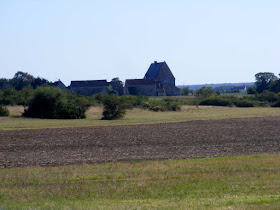Situated 20 km east of Tours the Champeigne is composed of two cereal growing plateaux divided by the valley of the Indre river. Roughly speaking it is the countryside between Bléré and Loches. Frankly, it looks nothing special (although it is dotted with very pretty villages) but as
Simon has already mentioned, today's landscape hides a record of an extraordinary level of prehistoric activity. In addition, it is home to some of our rarest and most vulnerable lowland plains bird species. As a result, ten years ago the
Champeigne Tourangelle was designated
as a special nature protection zone and integrated into the
Natura 2000
network, becoming one of six such areas in Indre et Loire.
Autumn Squill Scilla autumnalis (Fr. Scille d'automne) photographed near Sublaines. A rare and protected plant of dry grasslands on alkaline soil such as you get in the Champeigne Tourangelle.

The species the zoning is designed to protect are: Little Bustard
Tetrax tetrax (Fr.
Outarde canepetière), Eurasian Stone-curlew
Burhinus oedicnemus (Fr.
Oedicnème criard), European Golden Plover
Pluvialis apricaria (Fr.
Pluvier doré), Hen Harrier
Circus cyaneus (Fr.
Busard Saint-Martin), Montagu's Harrier
C. pygargus (Fr.
Busard cendré), Short-eared Owl
Asio flammeus (Fr.
Hibou des marais), Merlin
Falco columbarius (Fr.
Faucon émerillon), Short-toed Snake Eagle
Circaetus gallicus (Fr.
Circaète Jean-le-Blanc) and Red-backed Shrike
Lanius collurio (Fr.
Pie-grièche écorcheur). The zone stretches across seventeen local authorities: Athée-sur-Cher, Azay-sur-Indre,
Bléré, Chambourg-sur-Indre,
Chanceaux-près-Loches,
Chédigny, Cigogné,
Cormery, Courcay,
Dolus-le-sec,
Genillé,
Le Liège, Luzillé,
Reignac-sur-Indre, Saint-Quentin-sur-Indrois,
Sublaines and Tauxigny.
Autumn Squill in the grass on an uncultivated area in the Champeigne Tourangelle.
Although the designation is as a site for bird protection, it was very nearly designated as 'habitat' because of its chalk grasslands, but in the end the presence of 50% of the region's population of Little Bustard swung it for 'birds'. It was felt that protecting the bustard protected the rest of the species and their habitat. The bustards are counted annually to monitor their progress and earlier this year we saw three birdwatchers on the side of the road between Chédigny and Sublaines, just where I had seen a couple of bustards fly over a few year's earlier. They looked like professionals and I reckon they were doing the annual count.
The objective of the protection zone is to maintain, restore and develop the habitat of the open plain, corridor hedges and wooded copses in order to ensure the birds have a food supply, and mortalities and disturbances of the birds are minimised. Ninety-five percent of the land in the zone is either cultivated or fallow agricultural land. This means that the local farmers are simultaneously the greatest threat to the target species, and their greatest protectors, depending on how they choose to farm the land. Tourist and leisure activity in the zone is discouraged on the grounds that it inevitably disturbs the birds (hot air ballooning, quad bikes and tourist excursions are viewed particularly negatively in this regard). Also considered a problem are the electricity wires and the main roads and vehicular traffic traversing the zone.
What the Champeigne Tourangelle mostly looks like
(taken from what we think is the prehistoric trackway).

The success of the zone is seen to lie very much with the locals, and many farmers now participate in a programme to grow 'bustard pasture'. Mostly this works extremely well, with the farmers agreeing to grow lucerne which is mown for hay after the ground nesting birds have fledged their young and are more mobile.The management of the area is down to a committee of all the stakeholders and hopefully avoids issues such as inappropriate dates set for the haymaking and some means of negotiation when the season does not favour the farmer (eg if the summer is very dry and the lucerne loses nutritional value if left too long before cutting). For several years before the zone was created the local farmers and hunters rejected the project. It was only after the Communauté de Communes Loches Développement appointed a mediator that progress was made towards agreeing how the zone could be managed for the benefit of all. The objectives for the project were laid down by representatives from the Indre et Loire Chamber of Agriculture, the Hunt Federation for Indre et Loire, the League for the Protection of Birds (LPO) and the Society for the Study, Protection and Management of Nature in Touraine (SEPANT). The management committee is made up of a State official, a representative from each of the four organisations who created the objectives and three farmers. It is seen as essential that everyone has a voice and the power to influence the management of the Champeigne.
A typical farm, we believe medieval in origin.
Given that modern arable farming is the single most problematic threat to biodiversity in the Touraine (in my opinion at any rate) this is a really delicate balancing act. Modern agriculture does not favour arable 'weeds' or ground nesting birds. The Champeigne is a fence free mosaic of hard and soft wheat, oats, barley, canola and peas in the winter/spring and sunflowers, maize, barley, sorghum and millet in the spring/summer. This variety of crops actively contributes to maintaining the biodiversity. The Champeigne has been cultivated for so long it is part of the ecosystem now, and without it the land would completely change, taken over by invasive plants and other pest species.
A century ago the mosaic would have included pasture and domestic animals, but that disappeared as arable farming and especially cereals became more profitable and began to dominate. That is why the lucerne and the fallow land is an important part of the mix in today's management. It acts as a proxy for traditional extensively (ie the opposite of intensively) managed pasture.
Another typical view of the Champeigne Tourangelle.
The set aside or fallow land, known as les jachères in French, was until recently obligatory France wide and farmers were compensated for leaving land uncultivated. This was to reduce overproduction of cereals and try to control the build up of nitrates in the environment. Nowadays, with a world shortage of cereals, set aside is voluntary but many farmers continue to use the technique as part of their package of land management tools. They are encouraged to do so in areas such as the Champeigne where there is a concern about maintaining the traditional elements of the countryside, and a continuing concern about agricultural runoff (including nitrates) into the fresh water network.
***********************************************************
Au jardin hier: The growing season for this year has come to an abrupt halt, with a frost. My row of bean plants, which I sowed very late, still had lots of beans on them, but the frost has got them. I picked two thirds of the apples and have 10 big trays and 4 small ones of six different varieties in the pantry waiting to be made into jellies, compotes, crumbles and cakes. I've picked most of the grapes too, but that's more a result of the crop being small rather than me being worried about them. I'm gathering the walnuts as they fall, but they don't look as though they will be very good quality. I'll let them dry for a while before cracking them and finding out.
*************************************************
A la cuisine hier: Grilled pork chops, mashed potato, steamed carrots, creamed zucchini and a delicious spicy chutney that Simon's cousin Linda gave us, followed by a fresh pear.



















































